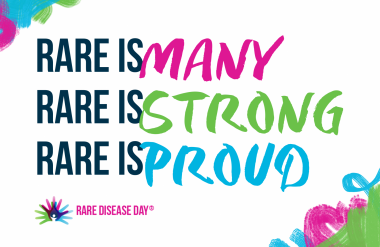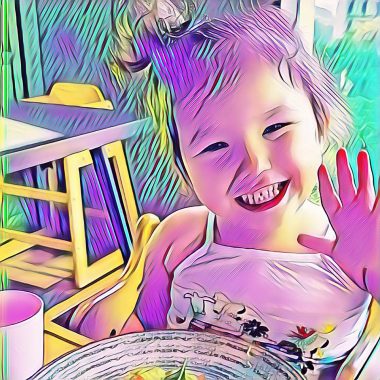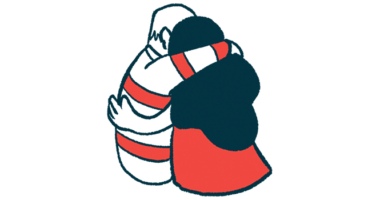On Rare Disease Day, Remember Our Strength

What are the chances that a girl from Taiwan would marry a man from the U.S., whom she happened to meet in Thailand, and unbeknownst to them, they were both autosomal recessive carriers of an ultrarare disease known as aromatic l-amino acid decarboxylase (AADC) deficiency?
Even though this astronomical occurrence did happen to us, there was only a 25% chance that our child would have the disease. I could never calculate the probability, but the answer was still the same. Our daughter, Rylae-Ann, was a rarity, one of only about 135 children in the entire universe who had AADC deficiency.
Initially, calculating the probability haunted me daily, and I would spend nights going in circles in my mind. I was driving myself crazy with numbers swirling around in my head.

The rare disease community is a network of unique individuals who go above and beyond each and every day. (Courtesy of RareDiseaseDay.org)
Developing a growth mindset
As I set out on this rare disease journey, I began with the premise that this anomaly was a curse. But why was I so pessimistic? That outlook is not how I’d been living. I needed to make a paradigm shift before I would be able to commit my entire being to support my daughter.
The mind shift did not prove to be that difficult.
I began by reframing the statement from a growth mindset perspective. Carol Dweck, PhD, is an “edu-famous” American psychologist known for her work on growth and fixed mindsets, and how these attributes translate to children’s motivation, success, and happiness. As a fellow teacher, I also instilled this ethos in my students, yet here I was, being a total hypocrite.
A growth mindset means accepting challenges as exciting opportunities. Instead of worrying about whether you won or lost, reflect on whether you gave your best effort and what you could do differently tomorrow. The effort that you put forward is what ultimately gives life meaning.
Once I developed a different attitude, my daughter began making progress. I became connected with more communities and received more help. My life was back on track, and my daughter was making fantastic memories with my wife and me.
This opened my eyes to the realization that this rare disease was not a curse. It was actually a blessing in disguise. We became strengthened, and our family’s world had access to new opportunities.
The strength in being rare
Later, I realized that being a part of the rare disease community gave our family a voice and platform to speak to others outside our community. Our story generates curiosity and attention each time we tell it. Listeners pick up their phone and Google AADC because the odds hook people into wanting to know more.
The community bond is also powerful. Meeting others in the rare disease community is like two long-lost friends reuniting after a long quest. The stories and troubles are identical. It feels incredible to connect with someone on that level, and the community begins to feel like an ultra-exclusive club with secret messages and codes that only the insiders know.

In this filtered photo, Rylae-Ann shows her colors for Rare Disease Day. (Photo by Richard E. Poulin III)
Rare is strong
Rare Disease Day on Feb. 28 is a celebration that unites more than 6,000 rare disease communities and aims to bring awareness, funding, and research to the estimated 300 million people worldwide who are diagnosed with a rare disease. In joining forces, we account for nearly 6% of the world’s population. We are not so rare after all.
We each have a unique story, and our diseases present unique challenges for each of us. Yet we share an important characteristic: perseverance. The journey is never easy, and we will have more challenges than most, but we have more opportunities for success.
Every day, my wife and I feel exhausted when we throw ourselves into bed. Some days, we are overwhelmed. However, on the days our daughter smiles or makes progress, all of those hardships disappear. I know we have been tested, but honestly, I don’t remember the pain when I look back. However, my heart swells when I think of the many fond memories we have shared with our daughter or others in our community.
On Feb. 28 and every day after, show your stripes and wear your colors proudly. For we are one of the few and strong, and we have so much to accomplish!
Note: AADC News is strictly a news and information website about the disease. It does not provide medical advice, diagnosis, or treatment. This content is not intended to be a substitute for professional medical advice, diagnosis, or treatment. Always seek the advice of your physician or other qualified health provider with any questions you may have regarding a medical condition. Never disregard professional medical advice or delay in seeking it because of something you have read on this website. The opinions expressed in this column are not those of AADC News or its parent company, Bionews, and are intended to spark discussion about issues pertaining to aromatic l-amino acid decarboxylase deficiency.







Leave a comment
Fill in the required fields to post. Your email address will not be published.